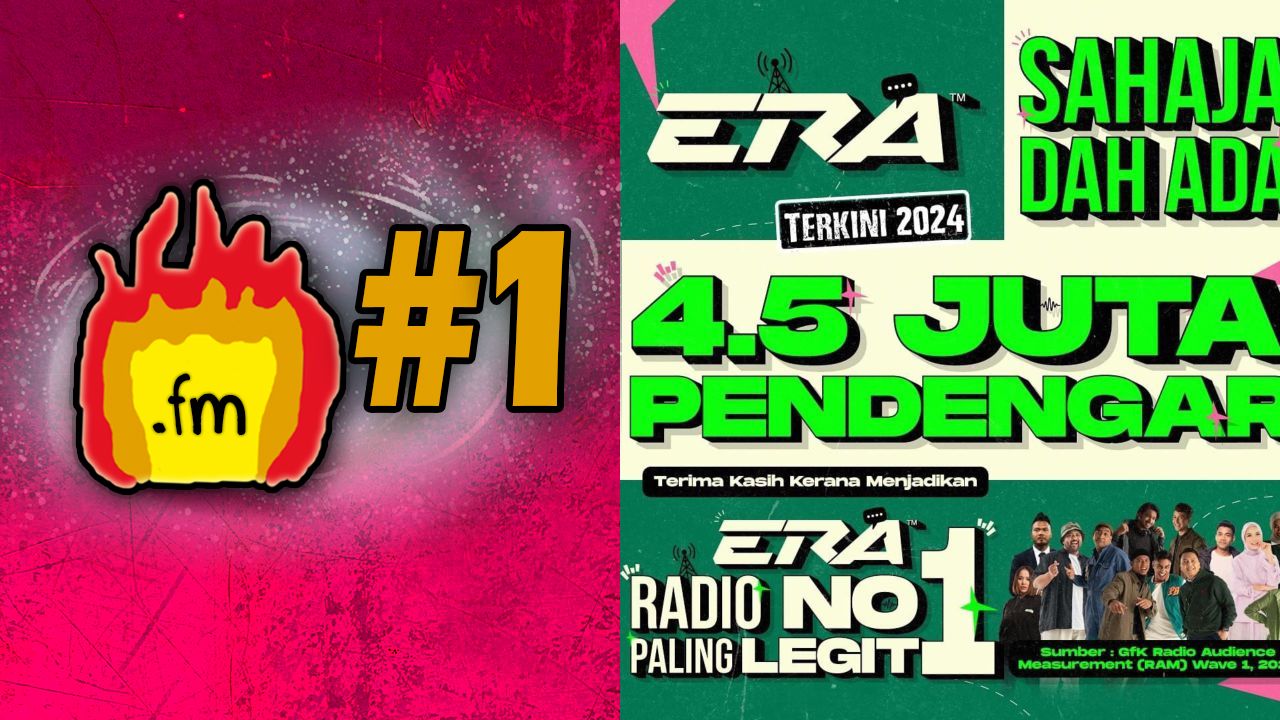ERA vs H** FM: Who’s really Malaysia’s #1 radio station?

- 1.4KShares
- Facebook695
- Twitter246
- LinkedIn168
- Email146
- WhatsApp144
You’re stuck in traffic, fiddling between radio stations. An announcer’s voice proudly proclaims you’re listening to ERA, the “#1 radio station in Malaysia”.
The traffic moves for a bit.
You fiddle with the stations again. Another announcer says you’re listening to H** FM, the “#1 radio station in Malaysia”.
It’s not deja vu, and your radio’s not broken. This is what Malaysians are noticing between ERA and another top Malay language radio station.

Now, you might be wondering, how come we can name drop ERA, but not the other station? Welp, that’s because we reached out to both stations for comments and got very different responses:
- ERA invited us over for tea (literal and metaphorical).
- The other station asked us to keep their name out of this article.
So, because we don’t want to get sued totally respect their request, we’re assigning them a totally random name that has absolutely no association with a Bahasa Malaysia radio station for the rest of this article: Huat FM.
This also leads to our disclaimer: This article will feel and sound berat sebelah towards ERA because well… you’re only hearing one side of the story. The other side speaker rosak.
We also spoke to industry folks and an independent consultant to piece everything together as much as we can. And let’s just say… the radio tea is hot panas.
It starts with how Malaysian radio stations measure who’s the #1 radio station
There wouldn’t be much drama if both radio stations were owned by the same company. But that’s not the case here – ERA and Huat FM are owned by different companies.
ERA is owned by Astro Audio. Since we also can’t name Huat FM’s owner, we’ll just call them “Media Pro Max”.
So how can both claim to be #1? Does this mean that one of them isn’t just spinning music but also… LIES?

On the surface, the explanation is obvious. Both radio stations must be using different measurements. And you’re right – they are!
Radio listenership is measured through surveys, and there are two research companies in question:
- GfK | Method: Radio Audience Measurement (RAM)
- Nielsen | Method: Consumer & Media View (CMV)
Thing is, both companies have very different ways of running their surveys. Here’s a rough overview of the differences:
GfK’s RAM method:
- Around 6,000 Malaysians are selected twice a year to fill out a 7-day radio diary.
- They log any live radio listening in 15-minute blocks, noting the time, location, and device used.
- The data is analysed to show who listens, when, where, and how, which state, language and more.
Nielsen’s CMV method:
- Nielsen interviews over 16,000 Malaysians individually throughout the year.
- CMV focuses more on who the listeners are and their lifestyle habits.
- It also goes beyond radio, covering TV viewership, print, online activity, product usage, and overall consumer behaviour.
The thing about surveys is that it all comes down to the methodology and objectives. To sum it up, RAM is focused specifically on radio while CMV has a broader focus on lifestyle and media consumption. Both are perfectly valid surveys done by reputable companies with years of experience in the business.

The only problem is, the perfectly valid RAM says ERA is #1, while the perfectly valid CMV says Huat FM is #1.
So yes, neither side is lying. They’re both the #1 radio station and they both have the receipts to prove it!
Now you might be thinking, okay, why not just one-two-jus and see which survey method to follow? Well, this is where it gets awkward.fm
Malaysian radio stations had an agreement to use GfK’s RAM

This is where we introduce Commercial Radio Malaysia (CRM). Basically, CRM is an association of Malaysian radio stations and counts most of your main radio channel operators as its members. This includes ERA’s parent company (Astro Audio) and Huat FM’s parent company (“Media Pro Max”).
Up til 2016, many radio stations were using Nielsen’s RAM to measure their listenership. Then, CRM stepped in and made GfK’s RAM the official industry standard.
Right now, 17 out of the 21 CRM member radio stations use GfK’s RAM. The remaining 4 stations use Nielsen’s CMV… and all 4 are owned by Media Pro Max.
“What actually happens is we have a tender process. It is something that is initiated by CRM, which is Commercial Radio Malaysia. And we go through our tender process to determine one survey method, one currency. And this is to really avoid situations like this where everybody says they are number one, right?”
– Priya Dharshini Prabakaran, Director of Astro Audio
So now it’s crystal-clear right? ERA is real #1 and Huat FM is fake #1 because of CRM’s rules.

Except… there aren’t actually any enforceable rules. Unlike the Malaysian Bar for lawyers, CRM isn’t a regulatory body. Rather, it’s closer to something like a friend group where you have bro code or girls code. So when some members of the radio community saw Huat FM releasing stats from a different survey provider…
“We were actually very shocked and we were like, ‘Hey I thought all of us agreed to use one currency,’ but in the CRM constitution there is no clause saying that you cannot publish another research house numbers. At the end of the day CRM is a guide. We among ourselves, it’s more like a bro code.”
– Rizal Sahimy, former CRM Secretary & current Astro Audio Head of Strategy
In other words, what CRM has are guidelines or best practices that would be nice for everybody to follow… please?
“You can claim a lot of things if you know how to play with the numbers actually. But, you know, it’s not wrong. It’s not criminal. But it’s kind of like below the belt.” – Rostam Said, Independent Media Consultant
Now, it wouldn’t be fair to paint CRM as a toothless buaya without talking to them. However, just like Media Pro Max, CRM also declined to be included in this article. You may chalk it up to, as Sabrina Carpenter puts it…
“What a coincidence oh na-na na-na na-na.” – Sabrina Carpenter
But here’s where things get a little spicy. The CRM presidency usually goes to someone from within the radio industry, and it’s normal for leaders of member stations to wear multiple hats. Coincidentally, the current CRM president also happens to be the CEO of…??

There are different opinions on what’s “best for Malaysia’s radio industry”
You guessed it. CRM’s top gun also wears another hat in Media Pro Max. Now, before anyone accuses anyone of nepotism, we’d like to emphasise that leadership at CRM tends to rotate among industry bigwigs, like a game of musical chair. In fact, that the other major player in this drama, Astro Audio , also held the CRM presidency from 2021 to 2022.

But regardless of who’s leading CRM, the organisation is supposed to be that uniting voice between all radio stations. So when the current president happens to also be running the network that’s breaking the bro code, some people are bound to question it.
“But for the radio industry, for the industry as a whole, we do need to have like a collective decision to make sure that what is best for the industry because when we do that, everyone can benefit from it.
If all of us are running on silos, you do your own thing, you do your own thing, there will be a market confusion. At the end of the day, everyone might just lose out.”
– Rizal Sahimy, former CRM Secretary & current Astro Audio Head of Strategy
However, all this plays out against a backdrop of a radio industry that’s been facing static. While radio listenership hasn’t dropped, revenues have. Back in the day, radio and TV were the best ways for brands to advertise. But these days, radio has to work extra hard to get a smaller slice of that advertising Ringgit pie.
“We used to be the apex of the food chain. Now we share the pie with Spotify, podcasts, YouTube.”
– Rostam Said, Independent Media Consultant

We don’t know for sure what Media Pro Max’s motivations are, but one thing’s for certain. It allows both sides to Bring Forth Money.
ERA’s business could benefit from this “#1 radio station” drama

Here’s the thing, the whole “we’re Malaysia’s #1 radio station” thing isn’t about convincing you, the listener, that this is the best station. It’s also about impressing advertisers and building credibility with international music labels.
Astro’s English Network Brand Manager, Navin Rishal, told us that being able to say “we’re number one” helps when negotiating with music labels flying artists in from overseas. Apparently, it gives them credibility, and lets them share data to back up that claim.
So, weirdly enough… all this drama over who’s #1 might actually benefit the people involved. As you might have noticed from celebrities, drama generates attention. And attention generates opportunities.
“All this noise about radio survey, I think it’s slightly exciting in the sense that people are talking about radio again. I know that it can be bit confusing. But also, it made people realize that, hey, radio is still relevant. There’s this whole market and radio share out there for advertisers to tap on.”
– Priya Dharshini Prabakaran, Director of Astro Audio
It also gave ERA a reason to turun padang and see firsthand how to make their content and messaging hit harder with businesses. When life gives you lemons, don’t just make lemonade. Make the best #1 lemona…oh wait.

“Instead of just shouting “we are number one”, we chose to go down and do the groundwork, And then we try to create more strategic content that can reach businesses better,”
– Alan Wong, AVP Research & Insight of Astro Audio [edited by Cilisos for clarity]
But at the same time, Priya points out that this isn’t necessarily healthy for the industry as a whole. When two giants fight and make a ton of noise, it can affect the smaller stations who will find themselves drowned out like a Temu speaker next to a Marshall amp.
For Astro Audio, it’s about ethics, principles and showing a united front

So yea, Astro Audio’s position is that they just want things to be done fair and square. To Priya, the purpose of having a tender process and choosing a standard survey is to show a united front among the radio stations.
“So, for me, we have been playing by the rules. We have no issue if everyone wants to change survey provider. I think what we need to do is really just end the contract. And then, when we do a tender again, it can be another survey provider. But let’s just follow the rules. Don’t just change things while a contract is still active.”
– Priya Dharshini Prabakaran, Director of Astro Audio
Besides, all this radio ga-ga and goo-goo also makes life harder for media agencies. These are the people who handle ad campaigns for clients, including the responsibility of deciding where their client’s advertising money goes. Being forced to navigate two different sets of data mean they have to do twice the work to plan and measure campaigns.
“It does complicate campaign planning, as every campaign now requires two rounds of checking that use different survey methodologies from pre to post.
Station selection and budget planning will depend on the client’s campaign objectives, target audience definition, and the type of insights or consumer listening behaviour required, as both surveys provide different information,”
– Media buyer from Ampersand Advisory
Which is why, if they had a choice, they would rather see a unified standard.
“Preferably, yes, if we are referring to just mainstream (linear) radio stations. This is to help all parties make a better and informed strategic decision on campaign planning,”
– Media buyer from Ampersand Advisory
So when even the media agencies don’t know who’s #1, where does that leave us?
Does a #1 radio station in Malaysia even exist?
This isn’t a philosophical question. Of course a #1 radio station exists. Officially, it’s based on statistics and surveys. But as you now know, the problem isn’t the numbers… it’s what people do with them. It’s a people problem.

It’s not a unique problem either. Billboard has been changing how they calculate album sales and streams in order to determine which song is actually the top of the charts. The DJ Khaled energy drink drama is probably the best example of this.
Our interviewees gave some suggestions to resolve the issue, such as hiring an impartial third party to run the CRM or agreeing to change survey providers. But these require all the radio stations (and their owners) to actually work together and follow the new rules. And here’s the catch – if that happened in the first place, then this drama wouldn’t exist at all.
We have to point out again that it’s very easy to paint Media Pro Max/Huat FM as the bad guy based on this article. And again, it’s because we are only able to present Astro Audio’s point of view. Or maybe you’re fully on team Huat FM and think Astro Audio are just being salty. That’s fine too.
“If it’s already causing confusion with the listeners, and all these clients who don’t follow on social media or don’t even know the story from an industry perspective right; from what we see out there, we can’t really defend ourselves.
Because every time we’re defending ourselves it looks like we’re being sore losers.”
– Priya Dharshini Prabakaran, Director of Astro Audio
Anyway, let’s answer the real question you came here for…
Who’s the real #1 radio station?
So, is there a true #1 radio station in Malaysia? On paper, yes. In practice, not really. When the industry can’t agree on a scoreboard, everyone gets to hold their own trophy.

ERA uses GfK’s RAM. Huat FM uses Nielsen’s CMV. Both surveys are legit, but they’re not measuring the same thing. Technically, both can claim to be #1… depending on which benchmark you’re looking at.
This isn’t just a numbers game, it’s a narrative war. Two radio giants, two different surveys, one guideline that’s not being followed, and an industry that looks a little messy from the outside.
And while the stats may be up for debate, your listening habits probably aren’t. So maybe the real winner is… the station you’re still tuning into tomorrow morning.
- 1.4KShares
- Facebook695
- Twitter246
- LinkedIn168
- Email146
- WhatsApp144
